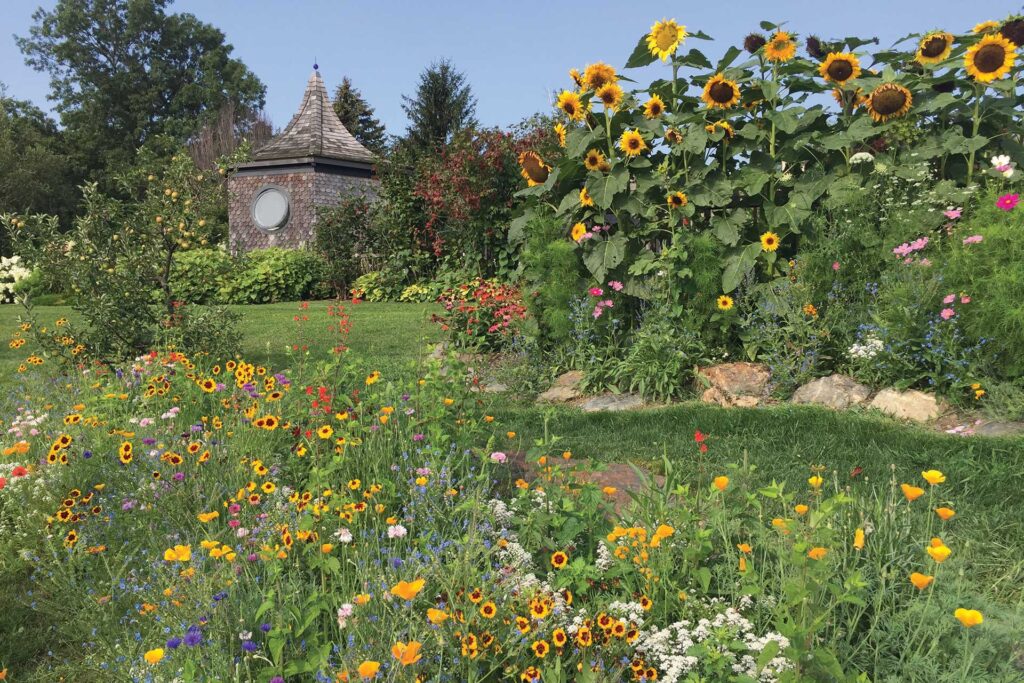Let’s talk about soil microbes. Sounds Sexy, right?
Pictures and Words by Mira Peck
You’ve heard all the buzz about “carbon gardening” and “regenerative agriculture,” right? OK, probably not, but once you learn more about it, please, spread the word. Some things in the garden shouldn’t be a secret.
Imagine a lush summer garden, full of vibrant flowers, buzzing bees, colorful butterflies and hummingbirds darting through the air. This type of garden only happens when you cultivate an important symbiotic relationship between plants and pollinators—this is when flowering plants attract insects to their flowers to give them a treat of nectar in exchange for helping them spread their pollen to produce seeds—something I, as a professional horticulturist, have been hyping for years.
Now I’d like to introduce you to a different symbiotic relationship, this one happening just below the soil surface between plant roots and microbes.
We’re all feeling the effects of climate change in the mountains: high temperatures, drought and more extreme weather events. For gardeners, it’s also these annoying early warming periods that kickstart early flowering and plant hormonal changes signaling it’s spring in January (which makes plants abort flowers, etc.) or late unexpected frosts that damage even hardy plants because their leaves have pushed out, but they haven’t hardened off yet.
Why is this happening? Through human activity, including industry, deforestation and the burning of fossil fuels, we’ve been releasing copious amounts of greenhouse gasses into the atmosphere (carbon dioxide and methane), trapping radiation and warming the planet. For most of the time humans have been here, carbon dioxide has accounted for about 0.03 percent of our atmosphere, or 280 parts per million (ppm) of it. Today, the system’s way out of balance, with carbon dioxide at more than 400ppm.
This excess carbon originally came from the ground (picture a huge oil well drilling into the Earth) and it can go right back into it again. How, you ask? Enter roots and microbes. When they team up, they can draw gaseous carbon from the air, convert it to liquid and then sequester it as solid carbon in the soil.
This is how it works: It starts with plants. To make their own food, plants use the process of photosynthesis to absorb sunlight through the chlorophyll in their leaves and draw up water through their roots (are you getting nostalgic for high school biology yet?). They use this energy from the sun to break apart the water molecules and then they release oxygen into the air through pores in their leaves. They draw carbon dioxide from the air through their leaf pores, which binds with the leftover hydrogen from the water molecules to create simple sugars and carbohydrates (plant food).
Plants use this food to grow and flourish, but they also secrete some of it out of their roots as “root exudates.” This seems like a waste of precious resources, but there’s a savvy reason behind it. Think of the obvious limiting factor that plants can’t move and therefore can’t always access all the nutrients from the soil that they need to grow and thrive. They need little helpers to go get nutrients for them that they can’t reach. Like how plants found helpers above ground to spread their pollen further afield (pollinators), plants found helpers below ground to access critical nutrients and hydration that’s out of their reach. There’s just got to be something in it for them: yummy exudates.
These helpers are soil microbes. A healthy soil is alive with microbes (bacteria, fungi, nematodes and others) that cycle organic matter and process minerals, all of which plants need. So, to get better access to those minerals, plants leak this liquid carbon in the form of simple sugars and carbohydrates (“cake and cookies” as the soil scientist Elaine Ingram calls them) so the microbes will start to colonize the root zone. In return, they help plants absorb nutrients and effectively carry minerals and moisture closer to the plant.
Now here’s how this helps the planet: Microbes also secrete substances from this process, one of which is a glycoprotein called glomalin. Glomalin’s super sticky, and it binds soil particles together into larger aggregates. These aggregates hold large amounts of stable carbon inside of them, carbon that’s protected and won’t just be cycled by microbes, remaining stable as sequestered carbon.
Voilà! A carbon sink, which acts as a safehouse for carbon holding it in the soil for very long periods of time if not disturbed.Here are some ideas to sequester carbon in your own yard:
Soil Covered With Plants
Leaving bare soil exposes carbon molecules to the air which then binds with oxygen and is released into the atmosphere; this is basically the opposite thing we want to have happening (a carbon pump). Plants prevent this from happening: Instead of leaving soil bare between crop rotations in your veggie garden, use a diversity of cover crops as a green manure; plant ground cover plants in your shrub or flower beds, as a living mulch.
Reduce Tilling
Tilling breaks up all the fungal hyphae and the soil aggregates that hold the stable carbon; it also exposes organic matter to oxygen.
No Synthetic Chemicals
These kill the biology in the soil so carbon cannot be sequestered, and plant health suffers.
Perennial Crops Are Best
That deep-rooted meadow you’re fantasizing about is the best carbon sink ever.
We do need to prevent further dangerous emissions, and we need to give the excess carbon already in the air a place to go. So, go forth and garden for Mother Earth, because the answer’s a living, healthy soil in conjunction with—every gardener’s dream—more plants. And there’s nothing ever wrong with that.













Comments are closed.